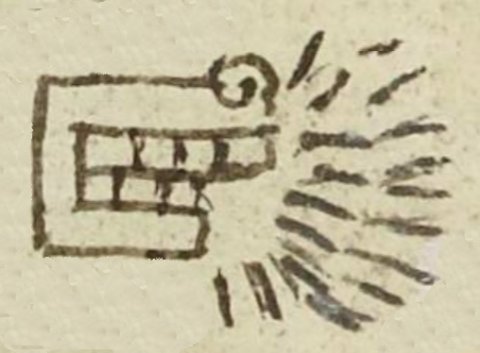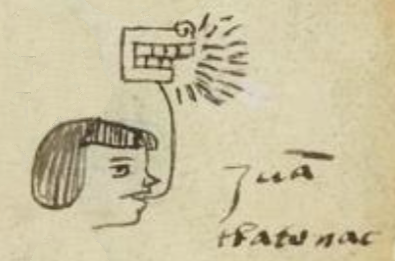Tlatonac (MH630r)
This black-line drawing of the compound glyph for the personal name Tlatonac (perhaps "Generator of Abundance") is attested here as a man's name. The glyph elements show a mouth full of teeth (tlantli), which provides a phonetic indicator for the Tla- start to the name. The mouth is shown in profile, facing toward the viewer's right. The lip above the teeth curls up and backward, suggesting an animal more than a human. Two rows of short radiating lines coming off the mouth are a semantic indicator for shine, as in the light and/or heat provided by the sun (the verb tona). They can also be a phonetic indicator for the Tlato- start to the name, part of the verb to speak, tlatoa.
Stephanie Wood
Tlatonac was the second part of the name of Tizocic, and Tlatonac meant "Generador de la Abundancia" according to Fernando Alvarado Tezozomoc's Crónica Mexicana (2018 edition). Elsewhere in this collection is the compound glyph for Chalchiuhtlatonac, which was the name of a female divine force of water and an early Mexica ruler.
Stephanie Wood
Juā
tlatonac
Juan Tlatonac
Stephanie Wood
1560
Jeff Haskett-Wood
speech, speak, hablar, brilla, calienta, tonalli, nombres de hombres, nombres de deidades, nombres de gobernantes

Tlatonac, a name held by high ranking Nahua leaders and associated with a female divine force of water, https://nahuatl.wired-humanities.org/content/Tlatonac
tona, to be warm, to feel the heat of the sun, for the sun to shine, https://nahuatl.wired-humanities.org/content/tona
tlan(tli), teeth, https://nahuatl.wired-humanities.org/content/tlantli
tlatoa, to speak, https://nahuatl.wired-humanities.org/content/tlatoa-0
Generador de la Abundancia
Fernando Alvarado Tezozomoc
Matrícula de Huexotzinco, folio 630r, World Digital Library, https://www.loc.gov/resource/gdcwdl.wdl_15282/?sp=342&st=image.
This manuscript is hosted by the Library of Congress and the World Digital Library; used here with the Creative Commons, “Attribution-NonCommercial-ShareAlike 3.0 License” (CC-BY-NC-SAq 3.0).







